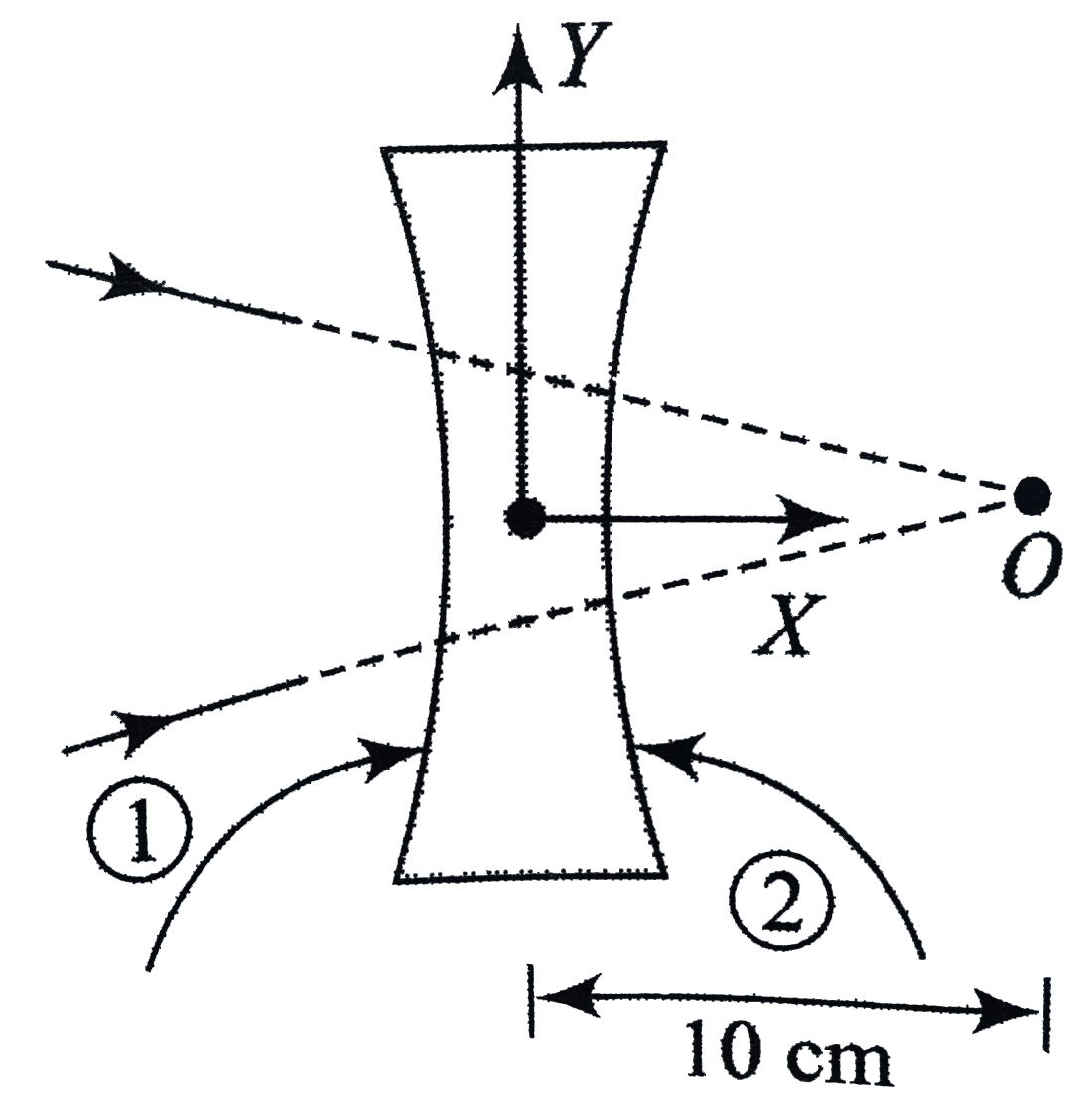The focal length of an equi-concave lens is 34 times of radius of curvature of its surfaces. Find the refractive index of the material of lens. Under what condition will this lens behave as a converging lens?
To solve the problem, we will follow these steps:
Step 1: Understand the given information
We are given that the focal length (f) of an equi-concave lens is 34 times the radius of curvature (R) of its surfaces. Therefore, we can express this relationship as:
f=34R
Step 2: Use the Lens Maker's Formula
The lens maker's formula for a lens is given by:
1f=μmμs−1(1R1−1R2)
For an equi-concave lens, both surfaces are concave, so:
- R1=−R (the first surface)
- R2=R (the second surface)
Thus, we can rewrite the formula as:
1f=μmμs−1(1−R−1R)
This simplifies to:
1f=μmμs−1(−2R)
Step 3: Substitute the value of f
Substituting f=34R into the lens maker's formula gives:
134R=μmμs−1(−2R)
This can be simplified to:
43R=−2μmμs−1⋅1R
Cancelling R from both sides (assuming R≠0):
43=−2μmμs−1
Step 4: Rearranging the equation
Rearranging the equation gives:
4(μs−1)=−6μm
This simplifies to:
4μs−4=−6μm
Rearranging further leads to:
4μs=6μm−4
μs=6μm−44
Step 5: Find the refractive index
We need to express μm. From the previous steps, we can isolate μm:
μm=4μs+46
Step 6: Determine conditions for converging lens
For the lens to behave as a converging lens, the focal length must be positive. Since we have an equi-concave lens, we need the term μmμs−1 to be negative. This means:
μm<μs
Conclusion
1. The refractive index of the material of the lens is:
μm=53
2. The condition for the lens to behave as a converging lens is:
μs>53
We are given that the focal length (f) of an equi-concave lens is 34 times the radius of curvature (R) of its surfaces. Therefore, we can express this relationship as:
f=34R
The lens maker's formula for a lens is given by:
1f=μmμs−1(1R1−1R2)
For an equi-concave lens, both surfaces are concave, so:
- R1=−R (the first surface)
- R2=R (the second surface)
1f=μmμs−1(1−R−1R)
This simplifies to:
1f=μmμs−1(−2R)
Substituting f=34R into the lens maker's formula gives:
134R=μmμs−1(−2R)
This can be simplified to:
43R=−2μmμs−1⋅1R
Cancelling R from both sides (assuming R≠0):
43=−2μmμs−1
Rearranging the equation gives:
4(μs−1)=−6μm
This simplifies to:
4μs−4=−6μm
Rearranging further leads to:
4μs=6μm−4
μs=6μm−44
We need to express μm. From the previous steps, we can isolate μm:
μm=4μs+46
For the lens to behave as a converging lens, the focal length must be positive. Since we have an equi-concave lens, we need the term μmμs−1 to be negative. This means:
μm<μs
1. The refractive index of the material of the lens is:
μm=53
2. The condition for the lens to behave as a converging lens is:
μs>53
Similar Questions
Knowledge Check
The power of a biconvex lens is 10 dioptre and the radius of curvature of each surface is 10 cm. Then the refractive index of the material of the lens is
A32B43C98D53A biconvex lens has focal length 23 times the radius of curvature of either surface. Calculate refraction index f material of the lens.
A1.75B1.33C1.5D1.0The radius of curvature of the curved surface of a plano-convex lens is 20cm. If the refractive index of the material of the lens be 1.5, it will
Aact as a convex lens only for the objects that lie on its curved side.Bact as a concave lens for the objects that lie on its curved side.Cact as a convex lens irrespective of the side on which the object lies.Dact as a concave lens irrespective of side on which the object lies.
A bicovex lens has radii of cuvature 20 cm each. If the refractive index of the material of the lens is 1.5, what is its focal length?
View SolutionFor a plano convex lens, the radius of curvature of convex surface is 10 cm and the focal length is 30 cm. The refractive index of the material of the lens is
View SolutionIf in a planoconvex lens, the radius of curvature of the convex surface is 10cm and the focal length is 30cm, the refractive index of the material of the lens will be
View SolutionA converging bundle of rays is intercepted by a biconcave lens. The radii of curvature of both surfaces are 20cm and the refractive index of the material of the lens is 1.5. If the rays originially converged to a point 10cm in front of the lens, where will they now converge after passing through the lens?

View SolutionIf in a plano-convex lens, the radius of curvature of the convex surface is 10 cm and the focal length of the lens is 30 cm , then the refractive index of the material of lens will be
View Solution
